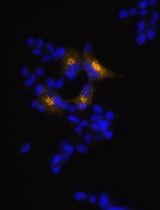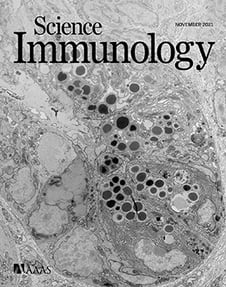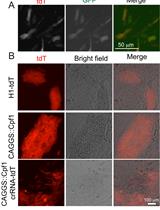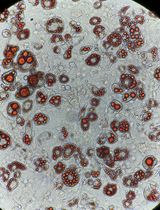- EN - English
- CN - 中文
Optimized CRISPR-Cas9-based Strategy for Complex Gene Targeting in Murine Embryonic Stem Cells for Germline Transmission
用于生殖系传递的基于 CRISPR-Cas9 的小鼠胚胎干细胞中优化的复杂基因靶向策略
发布: 2022年05月20日第12卷第10期 DOI: 10.21769/BioProtoc.4423 浏览次数: 3610
评审: Giusy TornilloNingfei AnVishal NehruAnonymous reviewer(s)

相关实验方案

利用EpiCRISPR系统通过靶向DNA甲基化诱导Alpha TC1-6细胞产生胰岛素
Marija B. Đorđević [...] Melita S. Vidaković
2025年10月20日 1175 阅读
Abstract
Although CRISPR-Cas9 genome editing can be performed directly in single-cell mouse zygotes, the targeting efficiency for more complex modifications such as the insertion of two loxP sites, multiple mutations in cis, or the precise insertion or deletion of longer DNA sequences often remains low (Cohen, 2016). Thus, targeting and validation of correct genomic modification in murine embryonic stem cells (ESCs) with subsequent injection into early-stage mouse embryos may still be preferable, allowing for large-scale screening in vitro before transfer of thoroughly characterized and genetically defined ESC clones into the germline. This procedure can result in a reduction of animal numbers with cost effectiveness and compliance with the 3R principle of animal welfare regulations. Here, we demonstrate that after transfection of homology templates and PX458 CRISPR-Cas9 plasmids, EGFP-positive ESCs can be sorted with a flow cytometer for the enrichment of CRISPR-Cas9-expressing cells. Cell sorting obviates antibiotic selection and therefore allows for more gentle culture conditions and faster outgrowth of ESC clones, which are then screened by qPCR for correct genomic modifications. qPCR screening is more convenient and less time-consuming compared to analyzing PCR samples on agarose gels. Positive ESC clones are validated by PCR analysis and sequencing and can serve for injection into early-stage mouse embryos for the generation of chimeric mice with germline transmission. Therefore, we describe here a simple and straightforward protocol for CRISPR-Cas9-directed gene targeting in ESCs.
Graphical abstract:

Background
The advent of CRISPR-Cas9 technology has led to a surge in interest in gene editing, due to its simplicity, speed, and low cost. CRISPR-Cas9 relies upon RNA-DNA binding, providing a significant simplification over previous gene editing methods like zinc-finger nucleases (ZFN) and transcription activator-like effector nucleases (TALEN), which rely upon protein-DNA binding at the site of interest and are therefore more cumbersome to engineer and not ubiquitously useful (González Castro et al., 2021). Due to its efficacy in vivo, CRISPR-Cas9 has quickly become a standard method for the development of genetically engineered mouse mutants. CRISPR-Cas9 machinery, composed of single guide RNAs (sgRNA), homology templates, and Cas9 protein, can be injected into zygotes for creation of chimeric offspring (Qin et al., 2016; Hall et al., 2018; Muñoz-Santos et al., 2020). However, depending on the nature of the desired genetic modification, the efficacy of correct mutagenesis can vary considerably, with a concomitant increase in mouse numbers and associated burden when creating new mouse lines.
An alternative strategy for utilizing CRISPR-Cas9 technology to create mutant mouse lines is to enhance classical gene targeting in murine embryonic stem cells (ESCs) (Oji et al., 2016). CRISPR-Cas9-mediated DNA double-strand breaks induce homology directed repair (HDR) for more efficient introduction of complex or multiple genetic alterations into the germline. Correctly mutated ESCs can be injected into early-stage mouse embryos to yield chimeric mice (Qin and Wang, 2019). Thus, ex vivo gene editing in ESCs can reduce mouse numbers for generation of specific gene modified lines and is aimed at improving the workflow in accordance with the principles of the 3Rs (replace, reduce and refine).
Here, we report an optimized workflow for the induction of targeted mutations in murine ESCs for subsequent germline transmission in mice. We established this protocol to introduce specific point mutations at two positions in exon 7 and exon 17 in the murine Malt1 locus in one step (O'Neill et al., 2021). The two missense mutations yield glutamate to alanine exchanges at amino acid positions 325 and 814 within the two TRAF6 binding motifs of the MALT1A protein and specifically abolish the interaction with the ubiquitin ligase TRAF6. This simple and straightforward protocol should be generally useful for almost any type of targeted mutagenesis of the mouse germline. In short, murine ESCs are transfected with CRISPR-Cas9 machinery using a lipid-based transfection system. Successfully lipofected cells are enriched via an EGFP marker by cell sorting and screened by qPCR using primers specific to the targeted mutation site. The use of lipofection and cell sorting yields mutant ESC clones more conveniently and faster than with classical protocols utilizing electroporation and subsequent selection by antibiotic resistance. The resulting ESC clones are potentially totipotent and competent for germline transmission upon injection into C57BL/6 mouse embryos, yielding chimeric mice for generation of the desired mouse line. This protocol provides a framework for researchers who seek to develop mouse models with complex, difficult or multiple mutation loci, including deletion of large stretches of DNA, insertion of exon-flanking loxP sites for conditional models, and insertion of reporter genes at specific loci. This workflow allows for high-throughput screening of ESC clones and an overall reduction of mouse numbers and associated burden.
Materials and Reagents
Cell lines and oligonucleotides
R1/E (129S1/X1) murine embryonic stem cells (ESCs)
Murine embryonic feeder (MEF) cells (prepared from wildtype mice)
Top10 chemically competent E. coli (produced in-house (transformation efficiency: 5 × 106) or commercially available cells [e.g., XL10-Gold Ultracompetent cells (Agilent, catalog number: 200317)]
Homology templates - Ultramer DNA Oligos, 2 nanomole scale (IDT)
Single guide (sg) RNA oligonucleotides - forward and reverse (Eurofins, 100 µM)
qPCR primers (Eurofins, 100 µM)
PX458 vector (pSpCas9(BB)-2A-GFP) (Addgene, catalog number: 48138)
Materials
10 cm Petri dishes (Corning, catalog number: 353003)
Pipette tips - various
96-well flat-bottom plates (Corning, catalog number: 3997)
96-well round-bottomed plates (Greiner, catalog number: 6500101)
3 mL FACS tubes (Falcon, catalog number: 352063)
6-well plates (ThermoFisher Scientific, catalog number: 140685)
100 µm cell strainer (Neolab, catalog number: GF-0061)
Lipofectamine 3000 transfection kit (Invitrogen, catalog number: L3000-001)
BbsI restriction enzyme (NEB, catalog number: R0539L, 10 units/µL)
T4 DNA ligase (Thermo Fisher Scientific, catalog number: EL0011)
NEB buffer 2.1 (10×) (NEB, catalog number: B7202S)
Sterile, nuclease-free water (VWR, catalog number: PD092)
NucleoSpin Gel and PCR Clean-up kit (Macherey-Nagel, catalog number: 7400609.50)
SOC medium (Life Technologies, catalog number: 15544034)
Ampicillin (Gibco, catalog number: 11593027)
LB agar (Carl Roth, catalog number: X9963)
LB (Luria/Miller) medium (Carl Roth, catalog number: X968.3)
Miniprep kit (DNA isolation kit) (Macherey-Nagel, catalog number: 740499.250)
Mitomycin C (MMC) (Sigma-Aldrich, catalog number: M4287-5x2mg)
DPBS (ThermoFisher Scientific, catalog number: 14190144)
OptiMEM medium (ThermoFisher Scientific, catalog number: 31985062)
Proteinase K (ThermoFisher Scientific, catalog number: 26160)
Trypsin-EDTA 0.05% (ThermoFisher Scientific, catalog number: 25300-054)
DMSO (Carl Roth, catalog number: A994.1)
DMEM medium (Gibco, catalog number: 41966-129)
KnockoutTM DMEM medium (Life Technologies, catalog number: 10829018)
Glutamax (Invitrogen, catalog number: 35050061)
NEAA (Gibco, catalog number: 11140-035)
Pen/Strep (Gibco, catalog number: 15140-122)
Fetal bovine serum (FBS) (Gibco, catalog number: 10270-106) – regular charge for MEF cell culture
ESC FBS (tested for ESC culture to maintain totipotency)
β-Mercaptoethanol (Thermo Fisher, catalog number: 31350010)
LIF/ESGRO (Millipore, catalog number: ESG1107)
EDTA (Carl Roth, catalog number: 8043.1)
Sodium chloride (NaCl) (Carl Roth, catalog number: 3957.2)
Tris (Carl Roth, catalog number: AE15.2)
1× SYBRTM Safe DNA Gel Stain (ThermoFisher Scientific, catalog number: S33102)
Ethidium Bromide solution 0.07% (PanReac AppliChem, catalog number: 1239-45-8)
Glycerol (Carl Roth, catalog number: 4043.3)
Sodium dodecyl sulfate (SDS) (Carl Roth, catalog number: 2326.2)
Bromophenol blue (Sigma-Aldrich, 115-39-9)
Xylene cyanol (Sigma-Aldrich, 2650-17-1)
10× annealing buffer (see Recipes)
MEF medium (see Recipes)
ESC medium (see Recipes)
2× MEF Freezing medium (see Recipes)
2× ESC Freezing medium (see Recipes)
10× MMC stock (see Recipes)
10× DNA loading buffer (see Recipes)
Equipment
Microscope (Carl ZeissTM, Axiovert 40 CFL equipped with a ZeissTM A-Plan 2.5×/0.06 objective and a ZeissTM E-PI 10×/20 ocular)
Fluorescence microscope (Life Technologies, EVOS FL)
Vortex (Merck, Vortex Genie 2, catalog number: Z258423-1EA)
Gel imaging system/UV transilluminator (INTAS)
NanodropTM 2000 (ThermoFisher Scientific, ND-2000)
Micropipettes (Eppendorf, variable volumes)
Multi-channel micropipettes (Eppendorf, variable volumes)
Tabletop cooling centrifuge (Eppendorf, 5417R)
Sterile bench (Thermofisher Scientific, HERASafe KS/Telstar, Telstar Bio II A)
LightCycler® Real-time PCR machine (Roche, LightCycler 480 II)
Autoclave (various)
Cell sorter (MoFlo, Cytomation, with Summit 4.3 software)
Electrophoresis chamber (Carl Roth, Midi)
Electrophoresis power supply (Sigma-Aldrich, Consort EV243)
Software
MoFlo® computer software (Summit 4.3 Software, Beckman Coulter); FlowJo (BD)
LightCycler® 480 software (https://lifescience.roche.com/en_de/products/lightcycler14301-480-software-version-15.html)
CRISPR-Cas9 guide design software such as CRISPick by BROAD Institute (numerous other options are available, see Cui et al., 2018)
Procedure
文章信息
版权信息
© 2022 The Authors; exclusive licensee Bio-protocol LLC.
如何引用
Readers should cite both the Bio-protocol article and the original research article where this protocol was used:
- O'Neill, T. J., Krappmann, D. and Gewies, A. (2022). Optimized CRISPR-Cas9-based Strategy for Complex Gene Targeting in Murine Embryonic Stem Cells for Germline Transmission. Bio-protocol 12(10): e4423. DOI: 10.21769/BioProtoc.4423.
- O'Neill, T. J., Seeholzer, T., Gewies, A., Gehring, T., Giesert, F., Hamp, I., Grass, C., Schmidt, H., Kriegsmann, K., Tofaute, M. J., et al. (2021). TRAF6 prevents fatal inflammation by homeostatic suppression of MALT1 protease. Sci Immunol 6(65): eabh2095.
分类
干细胞 > 胚胎干细胞
细胞生物学 > 细胞工程 > CRISPR-cas9
您对这篇实验方法有问题吗?
在此处发布您的问题,我们将邀请本文作者来回答。同时,我们会将您的问题发布到Bio-protocol Exchange,以便寻求社区成员的帮助。
Share
Bluesky
X
Copy link











